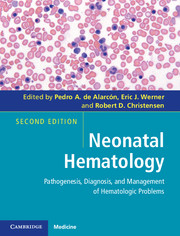Book contents
- Frontmatter
- Contents
- Contributors
- Foreword
- Preface
- 1 A historical review
- Section I Developmental hematology
- Section II Erythrocyte disorders
- Section III Platelet disorders
- Section IV Leukocyte disorders
- Section V Immunologic disorders
- Section VI Hemostatic disorders
- Section VII Transfusional medicine
- Section VIII Miscellaneous
- 20 Disorders of the feto-maternal unit
- 21 Neonatal oncology
- 22 Reference ranges in neonatal hematology
- Index
- Plate section
- References
21 - Neonatal oncology
from Section VIII - Miscellaneous
Published online by Cambridge University Press: 05 February 2013
- Frontmatter
- Contents
- Contributors
- Foreword
- Preface
- 1 A historical review
- Section I Developmental hematology
- Section II Erythrocyte disorders
- Section III Platelet disorders
- Section IV Leukocyte disorders
- Section V Immunologic disorders
- Section VI Hemostatic disorders
- Section VII Transfusional medicine
- Section VIII Miscellaneous
- 20 Disorders of the feto-maternal unit
- 21 Neonatal oncology
- 22 Reference ranges in neonatal hematology
- Index
- Plate section
- References
Summary
Introduction
Tumors in the neonatal period are rare (1). Several principles extend throughout the spectrum of neonatal tumors when compared with other tumors. Neonatal tumors are more often benign. If malignant, they are more difficult to treat and more likely to be genetic. Fetal circulation can change metastatic patterns of malignancies. In general, cancer is treated using surgery, radiation, and chemotherapy. However, in neonates, radiation is avoided and chemotherapy has increased morbidity and mortality. Additionally, neonatal tumors tend to be more primitive tumors that are less sensitive to chemotherapy. With the increasing use of prenatal ultrasound, more neonatal tumors are diagnosed prenatally, and perinatal treatment modifications can be made. This is especially important in large abdominal, oral, or cervical tumors. This chapter will review both malignant and benign tumors that occur in the newborn (Table 21.1). For malignant tumors, a basic overview, covering incidence, staging, differential diagnosis, and treatment, is included.
Epidemiology
Cancer in the newborn (defined for the purpose of this chapter as cancer diagnosed before one month of life) is a rare event. Cancers diagnosed in neonates make up only 1% of all cancers diagnosed in children under 15 years of age (2). Data from the Third National Cancer Survey (1961–71) reported the incidence of cancer in neonates being 36.5 per million live births, with 50% found on the first day of life (3). Data from the Surveillance, Epidemiology, and End Result program from 1973 to 1992 show the incidence of neonatal cancer is 26.8 per million live births (2).
- Type
- Chapter
- Information
- Neonatal HematologyPathogenesis, Diagnosis, and Management of Hematologic Problems, pp. 369 - 384Publisher: Cambridge University PressPrint publication year: 2013
References
- 2
- Cited by



